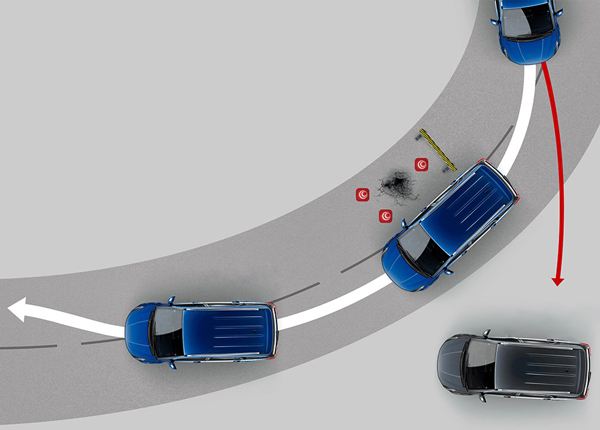
Correcting Traction Loss: Understeer and Oversteer Recovery for Drivers
Updated Dec. 25, 2020If you are fortunate and drive conscientiously, controlling a skid caused by traction loss is not something you should have to do often. However, you must understand what contributes to traction loss and how to solve it, as being underprepared when your vehicle begins to slide could make things a great deal worse.
“Do not panic” is the number-one rule when your vehicle starts to skid because of adverse weather, road conditions, or a poorly executed maneuver. Equally important is avoiding the urge to slam on the brakes – this will probably lock your wheels and worsen the skid.
Steering through a skid is the most effective way to correct traction loss. Most drivers have heard the “steering into the skid” mantra, though it is important to realize that this does not work in cases of understeering, when the front tires have lost traction. So, how will you know which way to steer in an emergency when your vehicle begins to skid? The easiest and fastest way to correct traction and handle skidding is to steer in the direction you originally intended the vehicle to go.
Understeer
Front-wheel traction loss or “understeer” typically occurs when trying to steer around a curve or corner. Your front wheels may lose traction and set your vehicle into a forward skid towards the roadside, rather than through the curve. Slick road surfaces as a result of unfavorable weather conditions are a common cause of understeer.
Turning into a corner or curve abruptly can also cause front-wheel traction loss. The outer surface of a tire has tread, to increase traction, as this is the area that is designed to have contact with the road’s surface. When the wheels are turned too sharply, the smoother sidewall of the tire may roll under the wheel, connect with the road and cause traction loss. When this happens, steering will be rendered ineffective and your vehicle will continue to cruise toward the edge of the road.
When driving conditions are adverse and an inexperienced or reckless driver is behind the wheel, loss of traction and an understeering accident are practically unavoidable. Several states – including Pennsylvania and North Carolina – have conducted studies into accidents and injuries as a result of maneuvering errors. The results show that the majority of front wheel skid, single-vehicle accidents occur when an inexperienced or teenage driver is at the wheel.
Correcting front tire traction loss
When your front wheels lose traction and begin to skid:
- 1

Look where you want to go.
Start by looking in the direction you want to travel, rather than staring directly ahead in the direction of the skid. This will help you react faster and not freeze-up. - 2

Steer in the direction you want to go.
Now, turn the steering wheel in the direction you want to go to realign yourself with the curve in the road. Ideally, you should make gentle steering adjustments in this direction, rather than throwing the steering wheel hard to the left or right. - 3

Pump the brakes.
Pump the brake once or twice. While braking during a skid is nearly always a bad idea, it can help you regain traction during an understeering situation, by shifting some weight back onto the front tires. - 4

Prepare for sudden movements.
Steering may respond sharply as traction is regained. You may experience a lurching sensation as tires grip the road and your vehicle starts to turn.
Oversteer
Rear-wheel traction loss can occur on slippery surfaces. It can also be caused by entering a turn at too high a speed, braking too hard or accelerating too rapidly. Unfortunately, poor vehicle control decisions like this can cause dramatic rear-wheel skids, even in extremely favorable conditions.
When rear tires lose traction the back end of your vehicle will swing out and move forwards. If corrective measures are not taken quickly, the car will continue to rotate until it is traveling backward. At this point, coming to a complete stop is your only option.
The condition of your tires also plays a major role in rear-wheel traction. You can lessen your chances of oversteer with the following precautions:
- Ensure your rear tires have the same tread-depth as your front tires or greater tread-depth.
- If you only buy two new tires at a time, use them to replace the tires on your rear axle.
- Make sure your tire pressure is correct. Over-inflated and under-inflated tires contribute to traction loss. Your vehicle owner’s manual will state your ideal tire pressure.
Correcting rear tire traction loss
Take the following action to regain control, when your vehicle enters a rear-wheel skid:
- 1

Look toward the intended direction of travel.
Do not look toward the side of the road. As with front-wheel skids, this will improve your ability to remain calm and respond. - 2

Steer in the direction you intend the vehicle to go.
With rear-wheel skids, this will mean steering in the same direction that your rear-wheels are skidding i.e. if your rear-wheels are swinging out to the left, steer left. - 3

Ease off the brake or accelerator to help wheels roll and regain traction.
You may initially need to steer beyond the desired path of travel to correct the skid. - 4

Steer steadily until the car is safely back in alignment with the road.
The momentum of your vehicle may cause it to start moving in the opposite direction as you correct the skid. Do not panic; steer gently. Sharp corrections could cause the vehicle to “fishtail”. - 5

Slowly accelerate to shift weight back onto the rear tires and improve traction.




